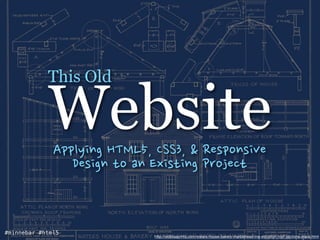This Old Website: : Applying HTML5, CSS3, and Responsive Design to An Existing Project
- 1. Website This Old Applying
- 2. ?HTML5,
- 3. ?CSS3,
- 4. ?
- 5. ?Responsive
- 6. ? #minnebar #html5 Design
- 7. ?to
- 8. ?an
- 9. ?Existing
- 11. #minnebar #html5 Why? http://oldblueprints.com/waters-house-bakery-marblehead-ma-elevation-roof-sections-plans.html
- 12. #minnebar #html5 Compatibility Maintainability Accessibility Flexibility Extensibility http://images4.fanpop.com/image/photos/20300000/Old-Ben-obi-wan-kenobi-20375221-1600-1200.jpg
- 13. HTML5 #minnebar #html5 http://oldblueprints.com/waters-house-bakery-marblehead-ma-elevation-roof-sections-plans.html
- 15. #minnebar #html5 DocType Semantic Markup HTML5 Shim Input Types Audio / Video Tags http://upload.wikimedia.org/wikipedia/commons/a/a9/Berg_van_stenen.jpg
- 16. !DOCTYPE html #minnebar #html5
- 17. #minnebar #html5 You have just taken your first step into a much larger world. B.
- 19. header/ nav/ section/ #minnebar #html5 footer/ aside/ article/ article/
- 20. #minnebar #html5 HTML5 Shim Bring
- 21. ?your
- 22. ?old,
- 23. ?broken
- 24. ?down,
- 25. ? non-compliant
- 26. ?browser
- 27. ? kicking
- 28. ?and
- 29. ?screaming
- 30. ?into
- 31. ? the
- 32. ?Century
- 33. ?of
- 34. ?the
- 35. ?Fruit
- 37. input type=¡±date¡± name=¡±bday¡± / color datetime datetime-local #minnebar #html5 email month number range search tel time url http://www.flickr.com/photos/22809952@N03/5480132725/
- 38. audio controls source src=/slideshow/this-oldwebsite/39801292/sound.ogg type=audio/ogg source src=sound.mp3 type=audio/mpeg Your browser does not support the audio tag. /audio ! ! video width=320 height=240 controls source src=movie.mp4 type=video/mp4 source src=movie.ogg type=video/ogg Your browser does not support the video tag. /video #minnebar #html5 http://audiodimensions.net/wp-content/uploads/2011/10/Home-theater1.jpg
- 39. #minnebar #html5 CSS3 http://oldblueprints.com/waters-house-bakery-marblehead-ma-elevation-roof-sections-plans.html
- 40. #minnebar #html5 Rounded Corners Shadows Gradients Webfonts Selectors Reset vs. Normalize http://upload.wikimedia.org/wikipedia/commons/a/a9/Berg_van_stenen.jpg
- 41. .round { /* Safari 3-4, iOS 1-3.2, Android 1.6- */ -webkit-border-radius: 12px; ! /* Firefox 1-3.6 */ -moz-border-radius: 12px; /* Opera 10.5, IE 9, Safari 5, Chrome, Firefox 4, iOS 4, Android 2.1+ */ border-radius: 12px; } #minnebar #html5 http://css-tricks.com/almanac/properties/b/border-radius/ http://www.flickr.com/photos/blujaguar/7907516644/
- 42. .shadow { /* Safari 3-4, iOS 4.0.2 - 4.2, Android 2.3+ */ -webkit-box-shadow: 3px 3px 5px 6px #ccc; /* Firefox 3.5 - 3.6 */ -moz-box-shadow: 3px 3px 5px 6px #ccc; /* Opera 10.5, IE 9, Firefox 4+, Chrome 6+, iOS 5 box-shadow: 3px 3px 5px 6px #ccc; } #minnebar #html5 http://css-tricks.com/almanac/properties/b/box-shadow/ http://www.flickr.com/photos/65839294@N03/8343399288/
- 43. #minnebar #html5 http://www.flickr.com/photos/crevisio/7568025270/ .gradient-bg { /* fallback/image non-cover color */ background-color: #1a82f7; ! /* Safari 4+, Chrome 1-9 */ background-image: -webkit-gradient(linear, 0% 0%, 0% 100% , from(#2F2727), to(#1a82f7)); ! /* Safari 5.1+, Mobile Safari, Chrome 10+ */ background-image: -webkit-linear-gradient(top, #2F2727, #1a82f7); ! /* Firefox 3.6+ */ background-image: -moz-linear-gradient(top, #2F2727, #1a82f7); /* IE 10+ */ background-image: -ms-linear-gradient(top, #2F2727, #1a82f7); ! /* Opera 11.10+ */ background-image: -o-linear-gradient(top, #2F2727, #1a82f7); ! /* fallback image */ background-image: url(/slideshow/this-oldwebsite/39801292/images/fallback-gradient.png); } http://css-tricks.com/css3-gradients/
- 44. Additional CSS3 Properties Border-Image Multiple Background Images RGBA Opacity Text-Shadow #minnebar #html5 Transition Transform Box-Sizing Column Count Animation And more! http://commons.wikimedia.org/wiki/File:20060513_toolbox.jpg
- 45. What about IE? css3pie.com #minnebar #html5 http://www.scenicreflections.com/download/411954/Neon_IE_Logo_Wallpaper/
- 46. #minnebar #html5 http://it.123rf.com/photo_12115422_grunge-newspaper-alphabet-with-torn-edges-isolated-on-black.html @font-face { font-family: Georgia, serif; font-weight: bold; src: url(/slideshow/this-oldwebsite/39801292/¡®Georgia.otf¡¯); } ! h1 { font-family: Georgia, serif; } google.com/fonts
- 47. Icon Fonts #minnebar #html5 http://it.123rf.com/photo_12115422_grunge-newspaper-alphabet-with-torn-edges-isolated-on-black.html
- 48. ¡°...³Ù³ó²¹³Ù
- 49. ?»å´Ç²Ô¡¯³Ù
- 50. ? #minnebar #html5 resize
- 51. ? or
- 53. #minnebar #html5 http://www.sweetwater.com/store/detail/Selector .class #id element element,element elementelement element+element attribute attribute=value attribute~=value :link :hover :first-letter :first-line :first-child :before :after :only-child :nth-child(n) :nth-of-type(n) :empty :enabled :disabled :checked :not(selector)
- 54. #minnebar #html5 reset vs. normalize http://www.flickr.com/photos/rrphotography101/5338711868/sizes/l/
- 55. Responsive
- 56. ? Design #minnebar #html5 http://oldblueprints.com/waters-house-bakery-marblehead-ma-elevation-roof-sections-plans.html
- 57. #minnebar #html5 Fluid Grids Media Queries Frameworks Alternate Navigation Tables Are Evil http://1800recycling.com/2010/07/recycled-shipping-container-buildings/
- 58. #minnebar #html5 100% = 1em ~= 16px ~= 14pt http://www.ecs.umass.edu/mie/tcfd/Programs.html
- 59. ¡°...³Ù³ó²¹³Ù
- 60. ?can
- 61. ?resize
- 62. ? and/or
- 63. ?scale¡± #minnebar #html5 http://www.stretcharmstrongworld.com/photo3_5.html
- 64. Media Query Breakpoint Guidelines #minnebar #html5 iPhone Portrait 300x356 iPhone Landscape http://www.websitedimensions.com/guidelines-css-large.png 380x208 iPad Landscape 1000x690 iPad Portrait : 740x916 Screen Height = 768 1240x540 Screen Height = 900 1240x650 Screen Height = 1050 : 1640x800 Screen Height = 1200 1880x1000
- 65. Target browsers between #minnebar #html5 768px and 701px @media all and (max-width: 768px) and (min-width: 701px) { body { font-size:0.8861111111111111em; } } http://www.flickr.com/photos/rafers/5619234395/
- 66. #minnebar #html5 HTML5 Boilerplate Fluid Baseline Grid 960grid 966grid Blue Print Bootstrap http://www.websitedimensions.com/guidelines-css-large.png
- 67. Alternate Navigation #minnebar #html5 http://dreamplango.com
- 68. #minnebar #html5 Tables are evil. http://www.flickr.com/photos/77790305@N02/8329280923/ table tr tdContent A/td tdContent B/td /tr tr tdContent C/td tdContent D/td /tr tr tdContent E/td tdContent F/td /tr /table ul liContent A/li liContent B/li liContent C/li liContent D/li liContent E/li liContent F/li /ul
- 69. Remodel
- 70. ? vs.
- 71. ? Teardown #minnebar #html5 http://oldblueprints.com/waters-house-bakery-marblehead-ma-elevation-roof-sections-plans.html
- 72. #minnebar #html5 Remodel Pixel perfect Insufficient budget Legacy browser support Continuous development http://oldblueprints.com/waters-house-bakery-marblehead-ma-elevation-roof-sections-plans.html
- 73. #minnebar #html5 Teardown Backend rewrite Major redesign Device / screen size support http://www.flickr.com/photos/maureendidde/3384264044/
- 74. #minnebar #html5 QA http://oldblueprints.com/waters-house-bakery-marblehead-ma-elevation-roof-sections-plans.html
- 75. Wolf Loescher #minnebar #html5 @wloescher brandpoint.com Bertine Buchan @bertine gage.com Download the slides bit.ly/Xuqj3g http://oldblueprints.com/waters-house-bakery-marblehead-ma-elevation-roof-sections-plans.html
- 76. HTML5 Resources http://html5please.com http://caniuse.com http://mediaelementjs.com/ #installation http://html5doctor.com/element-index/ #minnebar #html5
- 77. #minnebar #html5 CSS3 Resources http://css3please.com http://css3generator.com http://prefixr.com http://border-radius.com/ http://www.colorzilla.com/ gradient-editor/ http://necolas.github.com/
- 78. #minnebar #html5 Webfonts http://www.google.com/fonts/ https://typekit.com/ http://www.fontsquirrel.com/ http://icomoon.io/
- 79. Responsive Design #minnebar #html5 Resources http://cssmediaqueries.com/ http://css-tricks.com/snippets/ css/media-queries-for-standard-devices/ http://css-tricks.com/responsive-data- tables/ http://responsivepx.com












































































![[convergese] Adaptive Images in Responsive Web Design](https://cdn.slidesharecdn.com/ss_thumbnails/2012-adaptive-images-convergese-120509135732-phpapp01-thumbnail.jpg?width=560&fit=bounds)



















